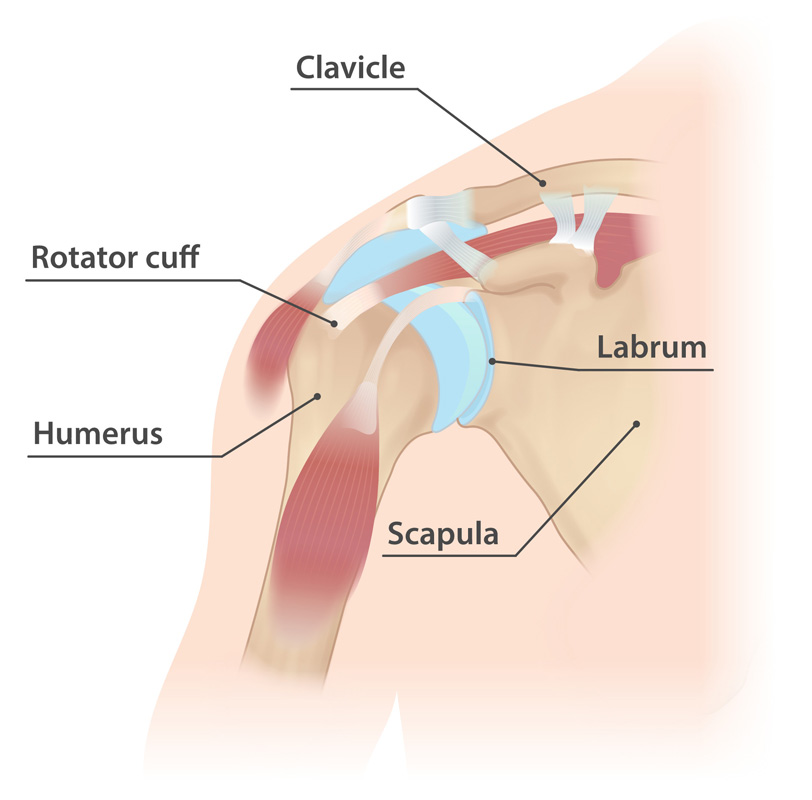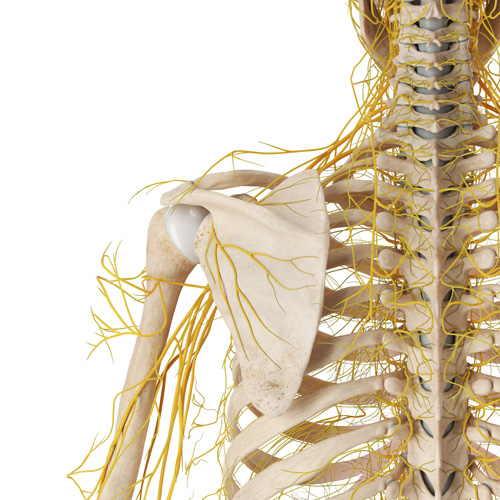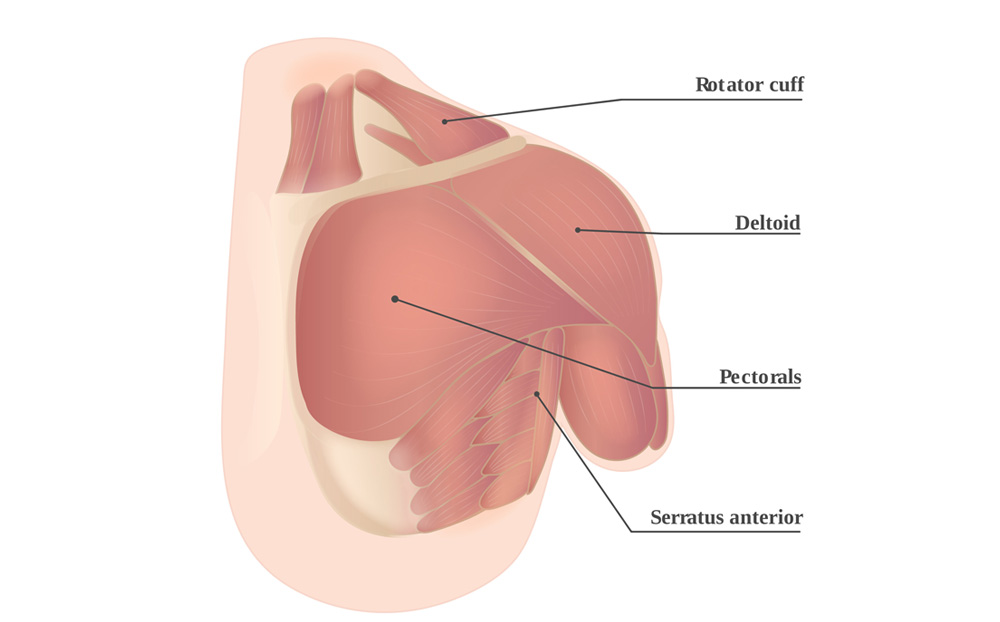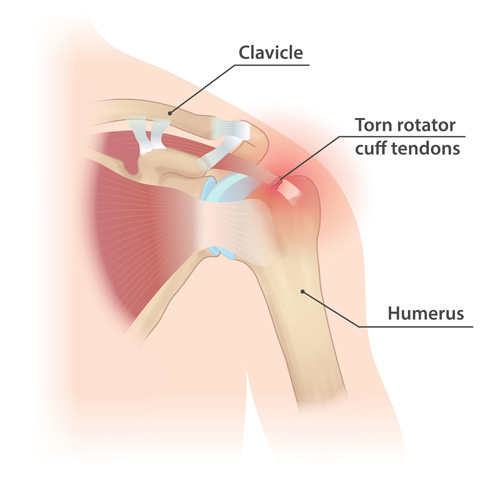Introduction To
Shoulder Anatomy for Pain Management
Shoulder pain is a very common chronic pain complaint and can inhibit a lot of my patient’s normal activities during the day. The shoulder is especially prone to injury as it is a mobile and complex joint that plays a vital role in any movement of the upper limb. A professor of mine once explained it best that the whole purpose of the shoulder, elbow and wrist is to bring one’s hands to interact with the environment around them. If your shoulder hurts, you can’t bring your hand to the fork to get food to your mouth! Understanding its anatomy is essential for patients managing shoulder pain, as issues can arise from four major buckets which include:
- Bones
- Nerves
- Muscles
- Tissues


Bones
The shoulder’s bony structure consists of three major bones that work together to provide stability and range of motion:
- Clavicle (Collarbone): Acts as a strut between the sternum and scapula. Fractures here are common and may cause shoulder instability.
- Scapula (Shoulder Blade): Anchors numerous muscles and plays a key role in shoulder movement. Conditions like scapular dyskinesis can cause persistent shoulder pain.
- Humerus (Upper Arm Bone): Articulates with the scapula at the glenohumeral joint. Fractures, arthritis, and rotator cuff issues frequently affect this bone.
Joint structures like the acromioclavicular (AC) joint, glenohumeral joint, and sternoclavicular joint are common pain points, particularly in cases of arthritis, dislocation, or impingement syndrome.
Nerves
The shoulder’s nerve network is essential for motor control and sensation. Key nerves influencing shoulder function include:
- Brachial Plexus (C5-T1): Controls arm movement and sensation. Nerve compression or irritation may lead to weakness, numbness, or radiating pain. It is important to remember that the cervical nerves from the neck supply sensation to the arm and shoulder. Part of our diagnostic evaluation will include differentiating structures from the neck that may be causing your shoulder pain.
- Axillary Nerve: Controls the deltoid and teres minor muscles; damage may result in difficulty raising the arm.
- Suprascapular Nerve: Provides sensation to the shoulder joint and controls key stabilizing muscles; impingement here can cause deep, aching pain. This nerve also can be targeted with interventional pain management procedures to block the pain from communicating back to the brain
- Radial, Ulnar, and Median Nerves: While primarily controlling the arm and hand, they may also contribute to referred shoulder pain.
Nerve impingement, neuropathy, or brachial plexus injury are common contributors to shoulder pain that may require targeted interventions.

Muscles
The shoulder’s muscle groups provide stability, control, and movement. Key muscles relevant to pain management include:

Rotator Cuff Muscles
The rotator cuff is a group of four muscles that stabilize the shoulder joint and facilitate movement.
- Supraspinatus: Initiates arm abduction and is frequently involved in impingement or tendonitis.
- Infraspinatus: Responsible for external rotation of the arm; strain or injury may cause posterior shoulder pain.
- Teres Minor: Assists with external rotation and stabilizes the shoulder during movement.
- Subscapularis: A powerful internal rotator that stabilizes the front of the shoulder; tightness or dysfunction can contribute to impingement.
Rotator cuff injuries, including partial or complete tears, are among the most common causes of shoulder pain and dysfunction. These injuries are often managed with physical therapy, cortisone injections, or surgical intervention if severe.

Other Shoulder Muscles
Muscle strains, overuse injuries, and imbalances are frequent sources of shoulder discomfort that can often be treated with targeted exercises, injections, or physical therapy.
- Deltoid: Provides power for arm elevation and abduction. Strain or weakness can limit shoulder mobility.
- Trapezius and Rhomboids: Support scapular movement and posture; tension or imbalance can lead to upper back and shoulder pain.
- Pectoralis Major and Minor: Control arm movement and chest stability; muscle tightness may contribute to postural shoulder pain.
- Biceps and Triceps: Support elbow movement but also attach to the shoulder joint, making them relevant to shoulder pain conditions.
Tissues
Connective tissues in the shoulder play a vital role in stability and function. Key structures include:
- Rotator Cuff Tendons: These attach the rotator cuff muscles to the humerus; inflammation or tears can severely impact shoulder movement.
- Glenoid Labrum: A fibrocartilaginous ring that deepens the shoulder socket; labral tears are a common source of persistent pain and instability.
- Ligaments: Such as the coracoclavicular, acromioclavicular, and glenohumeral ligaments, which stabilize the shoulder joint.
- Bursae: Fluid-filled sacs that reduce friction; inflammation (bursitis) is a common cause of localized shoulder pain. Key bursae in the shoulder include:
- Subacromial Bursa: Located beneath the acromion, this bursa reduces friction between the rotator cuff and the acromion. Inflammation here is a common cause of impingement pain.
- Subdeltoid Bursa: Positioned under the deltoid muscle, this bursa cushions the muscle from underlying structures and can contribute to pain with overhead movements.
- Subcoracoid Bursa: Found near the coracoid process, this bursa can become irritated with repetitive shoulder motions or impingement.
- Scapulothoracic Bursa: Located between the scapula and ribcage, this bursa can become inflamed with excessive shoulder blade movement, causing pain with shoulder motion.

Our Treatment Approach
At Mosaic Pain and Medicine Rehabilitation, we take a multidisciplinary approach to back pain treatment, combining diagnostic expertise, interventional pain procedures, and rehabilitation strategies to provide lasting relief.
-

Comprehensive Lifestyle
Lifestyle Modification Combined with patient tailored cognitive behavioral therapy referral, nutrition, vitamin supplementation
-

Physical and Occupational Therapy
Physical and Occupational Therapy for Functional Improvement
-

Non-Opioid Medication Management
Medications non opioids oral medications
-

Targeted Injections for Pain Relief
Injections; targeting muscle, nerve, bone or sympathetic
-

Neuromodulation Techniques for Pain Management
Neuromodulation; spinal cord stimulation, dorsal root ganglion stimulation, peripheral nerve stimulation
-

Specialist Referrals for Advanced Care
Referral to my colleagues specialized in orthopedic surgery, neurosurgery or neuropsychology.
General Questions
Shoulder pain can result from rotator cuff injuries, arthritis, bursitis, tendonitis, frozen shoulder, nerve compression, or muscle strain due to overuse or poor posture.
We offer physical therapy, injections (such as corticosteroid and trigger point injections), radiofrequency ablation, TENS therapy, and other non-invasive treatments to relieve pain and restore mobility.
You should seek medical attention if your pain persists for more than a few weeks, limits movement, worsens over time, or is accompanied by swelling, weakness, or numbness.
Yes, most cases can be managed with non-surgical treatments, including physical therapy, medication, injections, and minimally invasive procedures like nerve stimulation and radiofrequency ablation. Surgery is only considered for severe conditions.
Share this page:
Facebook
LinkedIn
Twitter
